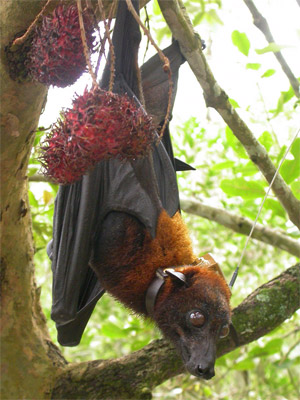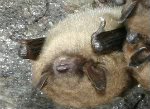Under the current legal hunting rate scientists predict that the world’s largest bat, the aptly-named large flying fox or Pteropus vampyrus, faces extinction in six to 81 years. Increasing the urgency to save the large flying fox is the vital role it plays as an ecosystem engineer (a species whose behavior can shape an ecosystem); the species maintains Southeast Asian forests by dispersing a wide variety of seeds over distances farther than most birds and other mammals.
To discover if current hunting is sustainable, Dr. Johnathan Epstein, a veterinary epidemiologist with the Wildlife Trust, and his team surveyed bat populations on Peninsular Malaysia from 2003 and 2007 and compared their findings with the number of hunting licenses issued by the Malaysian Department of Wildlife and National Parks.
 Threatened by unsustainable hunting the large flying fox is the world’s largest bat by wingspan. It also plays an important role as a seed disperser. Photo by: Jonathan Epstein. |
Their results published in the Journal of Applied Ecology found that currently 22,000 bats are hunted legally in Malaysia every year, an amount the scientists said was wholly unsustainable even under the researcher’s most optimistic population estimate of half a million individuals worldwide. Using computer modeling, the scientists predicted that if current hunting practices are not changed the bat would go extinct in six to 81 years. They hasten to add that this projection doesn’t even take into account the number of bats that are hunted illegally and the amount killed as pests by farmers every year.
“Our models suggest that hunting activity over the period between 2002 and 2005 in Peninsular Malaysia is not sustainable, and that local populations of Pteropus vampyrus are vulnerable to extinction,” Epstein said. In fact, due to this hunting pressure and habitat loss, the International Union for the Conservation of Nature (IUCN) upgraded the large flying fox’s status from Least Concern to Near Threatened in 2008.
In addition to surveying populations, Epstein and his team attached satellite transmitters to seven individual bats to see where the animals were moving and how far. They found that the greater flying fox could travel up to 60 kilometers (nearly 40 miles) in one night searching for food before returning to its roost, but when changing roosts the bat can fly hundreds of kilometers, crossing international boundaries, which may complicate conservation initiatives.
“Now that we know that these bats migrate between Malaysia, Thailand and Indonesia, coordinated assessments of their status throughout their range will be important for developing effective management strategies. Any additional hunting pressure on this species that occurs in Thailand or Indonesia may hasten the population’s decline,” Epstein said.
Currently, there is no unified program between the countries. The bats are heavily hunted in both Peninsular Malaysia and Indonesia, while it is illegal to hunt them in Malaysian Borneo and Thailand.
To save the species, Epstein and his colleagues recommend a temporary ban on hunting in the region to allow the greater flying fox time to recover current population loss. In light of Epstein’s study the Department of National Parks and Wildlife in Malaysia is currently reviewing their hunting policy.
The large flying fox has a wingspan reaching six feet (nearly two meters). It is hunted for food, medicine, and sport. Although hunting is not the only threat to the large flying fox’s future, the species is also losing habitat across its range due to rampant deforestation.
Citation: Jonathan H. Epstein et al (2009). Pteropus vampyrus, a hunted migratory species with a multinational home-range and a need for regional management, Journal of Applied Ecology, DOI: 10.1111/j.1365-2664.2009.01699.x, is published on 26 August 2009
Related articles
Extinction of Christmas Island Pipistrelle bat predicted in less than six months
(06/03/2009) The Australasian Bat Society predicts that the Christmas Island Pipistrelle bat has less than six months left until extinction, unless measures are taken immediately to set-up a captive breeding population.
‘Stopgap’ to preserve US bats from devastating fungus

(03/05/2009) Half a million bats have succumbed to a mysterious fungal disease known as white-nose syndrome in two years. Found in seven states in the northeastern US, this syndrome has left biologists baffled since first discovered in 2006. While researchers are still trying to uncover the relationship of the syndrome to the bats, a recent study published in Frontiers in Ecology and the Environment e-View suggests a way to mitigate the syndrome devastating affect. Employing a mathematical simulation the researchers found that using localized heat sources on hibernating bats may preserve populations while a long-term solution is found.
Massive bat species returns from the brink of extinction
(10/31/2008) A critically endangered bat species has made a dramatic recovery from the brink of extinction, report conservationists.













